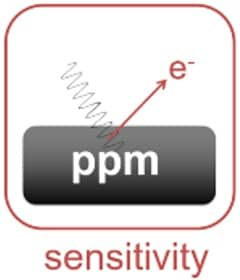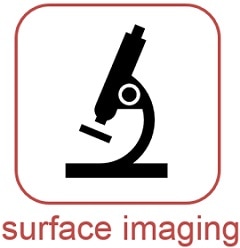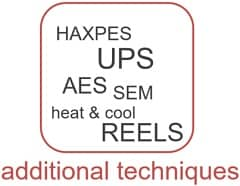AXIS Supra+ - Features
Imaging X-Ray Photoelectron Spectrometer
Sensitivity

The AXIS Supra+ provides excellent sensitivity in spectroscopy and XPS imaging modes. As with any form of spectroscopic technique, sensitivity is important in allowing collection of data in as short a time as possible. Short acquisition times are particularly desirable for materials that are sensitive to X-ray exposure. High sensitivity of the AXIS Supra+ also ensures easier collection of data from low concentration species and light elements with low photoelectron cross-sections.
- Ability to detect, measure and quantify lowest concentrations
- Faster acquisition times
Usability

Versatile ESCApe software has been developed to make User interaction with the spectrometer as simple as possible, integrating acquisition and processing to fully exploit automation of the hardware. An example of this is the group array analysis capability within ESCApe. This functionality allows the User to drag an area across a sample and define an array of analysis points, from which spectra are acquired. Automated peak identification and quantification allows easy generation of a colour concentration map of identified elements over the sample surface.
- Pre-defined ‘walk-up and use’ acquisition methods
- Complete computer control of AXIS Supra+ lowers barrier to entry for novice Users
- Integrated acquisition, data processing and interpretation software
Parallel XPS imaging

The lateral distribution of elements or chemistry at the surface is measured by XPS imaging. The AXIS Supra+ acquires fast, high spatial resolution parallel images. Parallel image acquisition has the advantage that it is significantly faster and achieves higher spatial resolution than the more conventional rastered beam approach. Parallel imaging may also be combined with stage movements to acquire a ‘stitched’ image, capable of generating images over several millimetres with spatial resolution of several microns.
Capabilities provided by parallel imaging include:
- Ultimate spatial resolution of 1 micron at the highest magnification.
- High energy resolution, chemical state imaging.
- Quantitative imaging – the unique spherical mirror analyser and delay-line detector can provide quantitative chemical state images.
- Spectromicroscopy – easy acquisition of spectra from image datasets providing a spectrum at each pixel.
Resolution

The very best resolution in spectroscopic and imaging mode is another fundamentally important property of any spectrometer. Spectroscopic resolution of the AXIS Supra+ out performs other instruments, allowing accurate and reproducible measurement of small chemical shifts used to determine surface chemistry.
Lateral, spatial resolution is important to be able to identify and image small surface features. Ultimate 1um image resolution is guaranteed using Kratos’ patented spherical mirror analyser (SMA).
Automation

Automation of the AXIS Supra+ improves the ease of use of the spectrometer and extends to all aspects of the spectrometer. Seamless automation means that the instrument can be operated remotely for data acquisition as well as applications and service support. The most important capability is the automated sample exchange between the sample entry and analysis chambers. Unattended sample exchange of up to 3 sample holders ensures continuous operation and extremely high sample throughput.
Automation also extends to swapping excitation sources during acquisition routines. This is demonstrated by sequential acquisition using the standard Al Kα and optional Ag Lα monochromatic X-ray sources for XPS characterisation. Gas handling for Argon ion sputter sources or the UV lamp for ultra-violet photoemission spectroscopy (UPS) is also fully automated.
Additional Analytical Techniques

The AXIS Supra+ is more than a photoelectron spectrometer. It can be configured with a complete range of additional materials characterisation techniques, without compromising XPS performance.
Coincident analytical techniques available on the XPS analysis chamber include:
- Hard X-ray photoemission spectroscopy (HAXPES)
- Ultraviolet photoemission spectroscopy (UPS)
- Ion scattering spectroscopy (ISS)
- Auger electron spectroscopy (AES) and secondary electron microscopy (SEM)
- Energy dispersive X-ray (EDX) analysis
- Reflection electron energy loss (REELS)
- Inverse photoemission spectroscopy (IPES)
Complimentary analytical techniques, available on a third, surface science station chamber include:
- Quadrupole secondary ion mass spectrometry (SIMS)
- Low energy electron diffraction (LEED)
Surface modification capabilities include:
- Heat & cool
- High temperature & pressure reaction cell
- Gas dosing
- Evaporation sources
- Air sensitive sample handling; glove box, inert sample transporter & modified sample bars
- In-situ, in-operando multi-contact sample holder
- Sample cleaver


